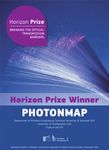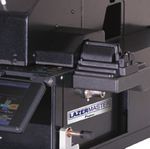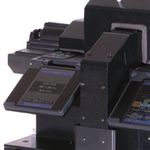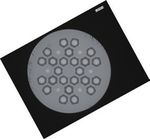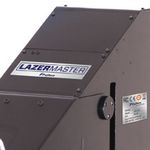I would like to wish everyone a Happy New Year.
←
→
Page content transcription
If your browser does not render page correctly, please read the page content below
I would like to wish everyone a Happy New Year.
The first half of the fiscal year was a severe market environment that resulted in
a decrease in revenues and income compared to the previous year. This mainly
was due to sudden yen appreciation and a drop in demand in the electronics
Masahiko Ito, President & CEO
business. However, operating income increased compared to original targets
despite a decline in sales thanks to our success in improving productivity, and other measures. Our operating
margin was 4.5%, which compared to the target 3.6%, indicates that we are maintaining and enhancing our
ability to generate profits. During the second half of the year, we anticipate that conditions in our operating
environment will remain severe due to a continuing lack of transparency with currency trends. Our ability to
generate profit will continue to be tested.
I would like every in-house company to work on the following initiatives. First, I would like the Power &
Telecommunication Systems Company to respond rapidly to the firm global demand for optical fiber. In the
energy business, I would like you position strengthening our EPC business in Myanmar and other emerging
markets as a cornerstone of our growth strategy while also promoting further structural reforms for our
domestic electrical wire business. In the Electronics Business Company, I ask that you rapidly ascertain
customer needs, produce samples and establish mass production systems corresponding to models for next
fiscal year, and strengthen quality control systems for our large-volume customers. I would like the
Automotive Products Company to achieve the successful launch of the LCC manufacturing sites, and advance
business development targeting Chinese car manufacturers. At the same time, I would like you to position our
response to the coming age of EV as a company-wide issue and collaborate with R&D unit and other in-house
companies to make advancements in this area.
The four core strategies of the 2020 Mid-term Business Plan are 1) developing deeper ties with strategic
customers, 2) speed up new business creation, 3) promote open innovation, and 4) implement management
and business structural reforms. Specifically, developing deeper ties with strategic customers involves 2017
strengthening our EPC and service business transactions with major communications companies overseas. We 1
are developing business in a way that enables us to accurately identify the value desired by customers and
provide total solutions.
We also are offering SWR/WTC optical cables to core clients overseas. SWR/WTC are our newly developed
thin, lightweight optical cables that are easy to install and easily adapted to suit customer needs.
In the area of R&D, instead of focusing on detached domains, we will secure the superiority of “Tsunagu
(connecting)" technology by strengthening three technology platforms ‒ electrical wires and cables, optical,
and electronic products. Furthermore, we will promote R&D aimed at expanding new business in the medical,
industrial equipment, and automotive products segments. Furthermore, by developing deeper ties with
strategic customers and promoting open innovation, we will identify social changes and customer needs
ahead of our competitors to create the new technology and new products desired by our customers. In doing
so, we further accelerate our ability to achieve powerful innovation.
Let’s all work together to make this another healthy, successful year!Fujikura News
Tele-
communi-
Sales Launch of
cations
New CO2 Laser Splicer Series
Fujikura has put the LZM-110 Series, CO2 laser optical fiber fusion splicers, on the market. These
splicers are distinguished by the use of a CO2 laser for fusion splicing special optical fibers such as
large-diameter fibers and processing fiber edges. The fusion splicers are expected to find a wide
range of applications including optical devices, medical equipment, various sensors, research and
development.
The use of CO 2 laser as the heat source allows fusion splicing of optical fibers with an outer
diameter as large as up to 2.3 mm. Doing this work, however, is difficult for the ordinary system, in
which optical fibers are heated by electric discharge. The new fusion splicers are capable of
processing fiber edges with a ball-lens by using dedicated software.
The LZM-110 Series products are much smaller and lighter in weight than the LZM-100 Series and
thus can be set on a table. The addition of four fusion splicers under the LZM-110 Series will offer
the user a wide choice of options.
Fusion splicing of 1 mm-dia. fiber and 2 mm-dia. fiber
Photo image of the LZM-110 series product
External dimensions (W ×D× H) 482 ×584 × 843 mm
Weight 26 kg
Processing of ball-lensed edge
E
Precision Equipment Division optfsm@jp.fujikura.com
Our website for splicers http://www.fusionsplicer.fujikura.com/jp/R& D
Fujikura awarded Horizon Prize together
with Technical University of Denmark
and University of Southampton
Researchers from Fujikura, Technical University of Denmark (DTU), and University of Southampton
received Horizon Prize for Breaking the Optical Transmission Barriers from the European
Commission for their joint research using Fujikura's multi-core fiber.
Horizon prizes are 'challenge' prizes under Horizon 2020 (EU's research and innovation program
with nearly €80 billion of funding available over 7 years from 2014 to 2020).
The research was conducted using DTU's single photonic chip-based
supercontinuum source, Fujikura's multicore fiber, and University of
Southampton's multi-core erbium doped fiber amplifiers. The results
showed that 1Pbit/s or higher optical transmission over 1,000 km was
achieved without complicated electrical treating of the
transmission line, which lead to the prize.
In addition, this research is part of the SAFARI (Scalable
And Flexible optical Architecture for Reconfigurable
Infrastructure) project funded by Ministry of Internal
Affairs and Communications and the European
Co m m i s s i o n ' s H o r i z o n 2 0 2 0 u n d e r S t r a t e g i c Cross-section of
Information and Communications R&D Promotion newly-developed
multi-core fiber
Programme. E
Advanced Technology Laboratory fjk.ocdept@jp.fujikura.com
Fujikura Joins IZB 2016
Electronics
&
Auto
International Suppliers Fair (IZB) 2016 was held in Wolfsburg, Germany between October 18 and 20.
The Fujikura Group put on display various products such as harnesses, cables, connectors, flexible
printed circuits, thermal products, and assemblies for next generation vehicles. Among these exhibits,
the demonstration of AOC (active optical cable), which transmits data as fast as 56 Gbps, attracted
many visitors' attention. We had many of our major European customers in our booth and good
discussions with them. The
event was so meaningful
that we were able to see
future development of the
automotive business.
Demonstration of AOC
E
Automotive Electronics Component Company automotive@jp.fujikura.comTele-
communi-
Development of Slim Die-sensitized Cells
for Energy Harvesting
cations
Fujikura has developed a die sensitized cell (DSC) that will be most suitable for energy harvesting
use. In the IoT field, where technical development is underway, many sensing systems are expected
to be used in different places in the future. Energy harvesting is assumed to be an effective
environmentally friendly method to operate these sensors because the system does not require the
installation of an AC outlet or battery replacement, or produce waste.
Last year, Fujikura launched the sales of DSCs for energy harvesting, which displays excellent
performance in conditions without direct sunlight. Meanwhile, we have been further downsizing
DSCs in keeping with the miniaturization of sensors.
We have developed an energy harvesting DSC with a 1.2 times wider effective generating area than
the previous model and half the thickness, 2.5 mm, of it after succeeding in simplifying the sealing of
the DSC without sacrificing long-term reliability. It is expected that rapidly spreading IoT sensor
systems will operate completely without batteries and that net-zero energy buildings (ZEB) will be
put to practical use. To support the development of green society, Fujikura will keep working on
DSCs.
Note: Backside on top
Back side of module
Front side of module Conventional New module
(light-receiving surface) module
New energy harvesting DSC module Comparison of thickness with old module
Comparison of properties with cold module
Conventional module (FDSC-FSC4) New module
Outer dimensions (W×D×H) 112 × 56 × 5.0 mm 112 × 56 × 2.5 mm
Effective generating area 40.6 cm 2
48.2 cm2
Typical output (white LED 200 lux) 250 μW 300 μW
Note: The values in the graph are those of modules under development and can be different from those of products.
E
Advanced Technology Laboratory ask-dsc@jp.fujikura.com
Fujikura Ltd. Sales Support & Branch Off ice
Management Department +81(0)3 5606 1095
1-5-1, Kiba, Koto-ku, Tokyo, Japan 135-8512
Kansai Off ice +81(0)6 6364 0373
TEL. +81(0)3 5606 1112 FAX. +81(0)3 5606 1501 Chubu Off ice +81(0)52 212 1880
Issue : January 2017, No. 426 Editor in Chief : Keisuke Okamura Tohoku Off ice +81(0)22 266 3344
http://www.fujikura.co.jp Kyushu Off ice +81(0)92 291 6126You can also read




